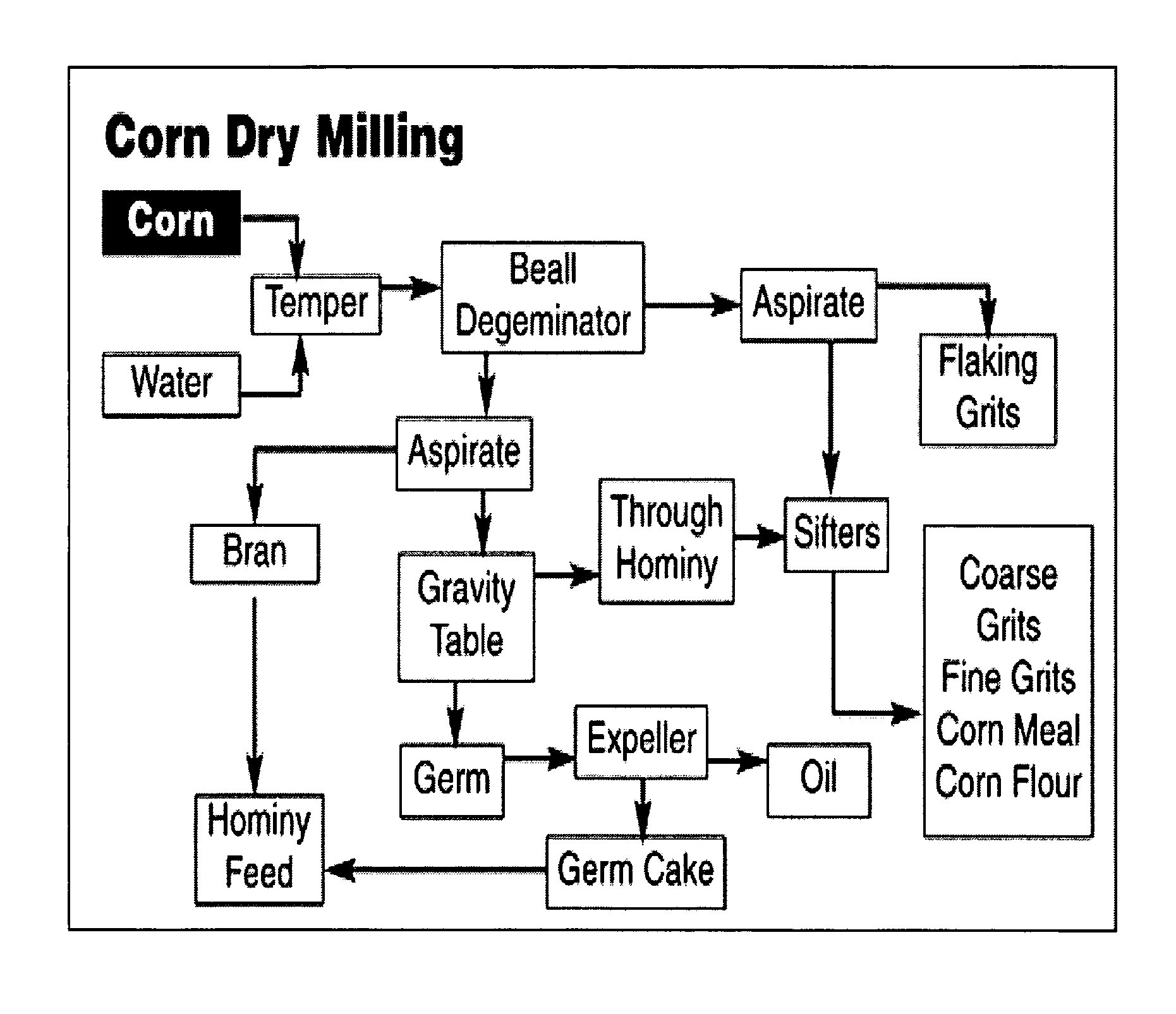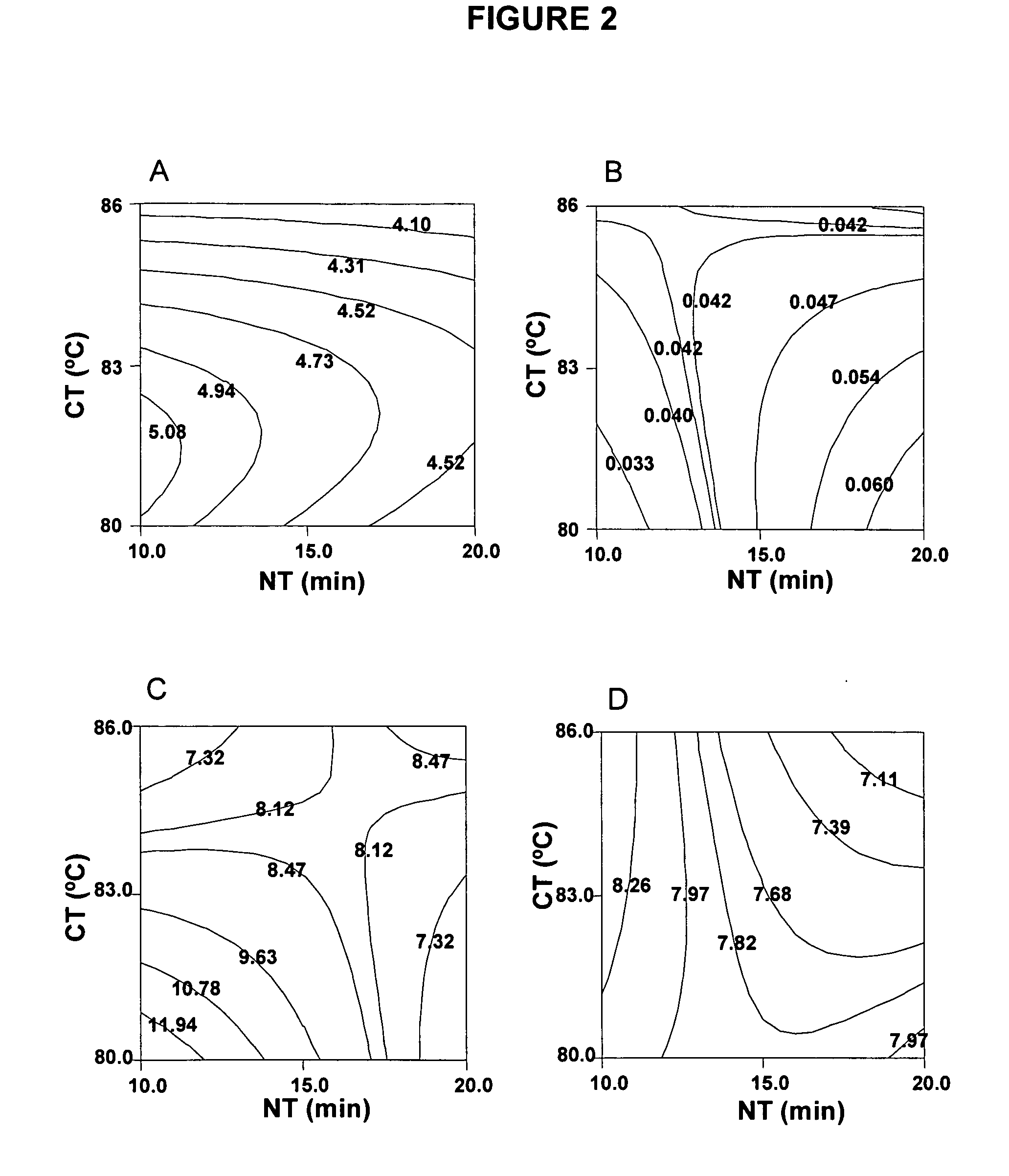[0024] Optionally, endosperm fractions can be more finely divided by size into sub-fractions of grits, meal and / or flour, and each subfraction individually nixtamalized. The food product can comprise one or more than one nixtamalized endosperm sub-fraction. The food product can comprise only one nixtamalized endosperm sub-fraction. The food product can comprise only two nixtamalized endosperm subfractions. The food product can comprise three or more nixtamalized endosperm subfractions. The food product can comprise one or more nixtamalized endosperm sub-fractions, but not all of the endosperm. Alternatively, the food product can also comprise any one or more of the nixtamalized endosperm fraction and any one or more of the nixtamalized endosperm subtractions. The food product can comprise any one or more of the nixtamalized endosperm fraction and any one or more of the nixtamalized endosperm subtractions, but not all of the endosperm.
[0025] The nixtamalization conditions of whole corn kernels are known in the art. The endosperm fractions and / or subtractions can be cooked in an alkaline solution. The solution can be made from between 0.8% and 1.2% weight by volume of lime in water. The solution can be a 1% weight by volume of lime in water. Depending on the size range of the endosperm fraction or subtraction and the initial moisture content of the fraction or subtraction, the ratio of lime solution to endosperm fraction or subtraction can range between three parts and seven parts solution to one part fraction or subtraction. The ratio of lime solution to endosperm fraction or subtraction can range between four parts and six parts solution to one part fraction or subtraction. The initial moisture content of the fraction or subtraction can be between 8% and 11%. The initial moisture content of the fraction or subtraction can be approximately 9.5%. Depending on the fraction's or subfraction's size range, the cooking time can be less than 20 minutes. Generally, the smaller the fraction or subtraction size, the lower the cooking time. Corn grits can be cooked for approximately 18 minutes. Corn meal can be cooked for approximately 15 minutes. Corn flour can be cooked for less than 15 minutes. The cooking temperature can be approximately between 80° C. and 86° C. The cooking temperature can be 83° C. for corn grits and 83° C. for corn meal. The cooked fraction or subtraction can be steeped at room temperature for between four and six hours, or until such time that no nejayote remains after steeping. The corn grits and corn flour can be steeped at 25° C. for five hours. The nixtamalized endosperm fraction or subtraction can contain between 43% and 47% moisture content. The nixtamalized endosperm fraction or subtraction can contain approximately 45% moisture content.
[0026] For the food products that comprise more than one nixtamalized fraction and / or subtraction, each nixtamalized fraction and / or subtraction can be blended immediately following steeping to obtain a homogenous blend. Alternatively, each fraction or subfraction can be dried, grounded and mixed to form a homogeneous blended instant masa.
[0027] Optionally, the non-endosperm corn kernel fractions (e.g. pericarp and / or germ) can be added to the one or more nixtamalized endosperm fractions and / or subfractions. In one embodiment, a controlled amount of germ can be added to the one or more nixtamalized endosperm fractions or sub-fractions. The non-endosperm corn fractions can themselves be nixtamalized (separate from the endosperm) or simply hydrated by cooking in water. Increasing the amount of germ added back to the nixtamalized endosperm increases the fat content of the end food product. In this manner, the fat content of tortillas can be varied from less than 10% of the fat of a conventional tortilla (e.g. approximately 0.2% fat) up to 100% (or even greater by adding excess germ) fat of a conventional tortilla (1.6 to 2% fat), and any amount between. Similarly, the method can include varying the amount of pericarp added back to control the end food product fiber level, from approximately less than 1% to greater than 100% the fiber content, and any amount between, of a conventionally nixtamalized food product.
[0028] The invention is also food products made from the methods of the present invention. The food products are of the kind that can be generally made from the traditional corn nixtamalization process, including masa, instant masa, tortillas and tortilla-related products including tortilla chips, tamales, atoles, arepas, and pupusas, and any other masa-derived food products. The invention comprises food products derived from nixtamalized corn endosperm fractions and / or subfractions that contain lower (or higher) fat and lower fiber than food products prepared by traditional nixtamalization processes. The food products can contain controllable amounts of fat by addition of controllable amounts of germ to the nixtamalized endosperm fraction(s) and / or subfraction(s). The food products can contain controllable amounts of fiber by addition of controllable amounts of pericarp to the nixtamalized endosperm fraction(s) and / or subfraction(s).
[0029] The food products, therefore, can contain any amount of germ or fiber, ranging from approximately 0% to greater than 100% of a conventionally-made food product, including between 1% and 50%, between 1% and 25%, and all sub-combinations in between. In addition, the food products can contain controllable amounts of fiber, ranging from between approximately 25% of a conventional food product to greater than 100% of the fiber contained in a conventional food product, and any sub-range between. Conventional food product refers to those foods that can be made from conventional instant masa flour, wherein the fat content of the conventional masa flour is approximately 3.5%-4% fat by weight. In one embodiment, the present invention is corn masa flour whose fat content is less than 3.7% fat by weight. The corn masa flour can have a fat content less than 2% by weight. The corn masa flour can have a fat content less than 0.5% by weight. The food product can be a low-fat or reduced-fat and high fiber corn tortilla, containing greater amounts of fiber compared to a food product made from the traditional nixtamalization process.
 Login to View More
Login to View More  Login to View More
Login to View More 


